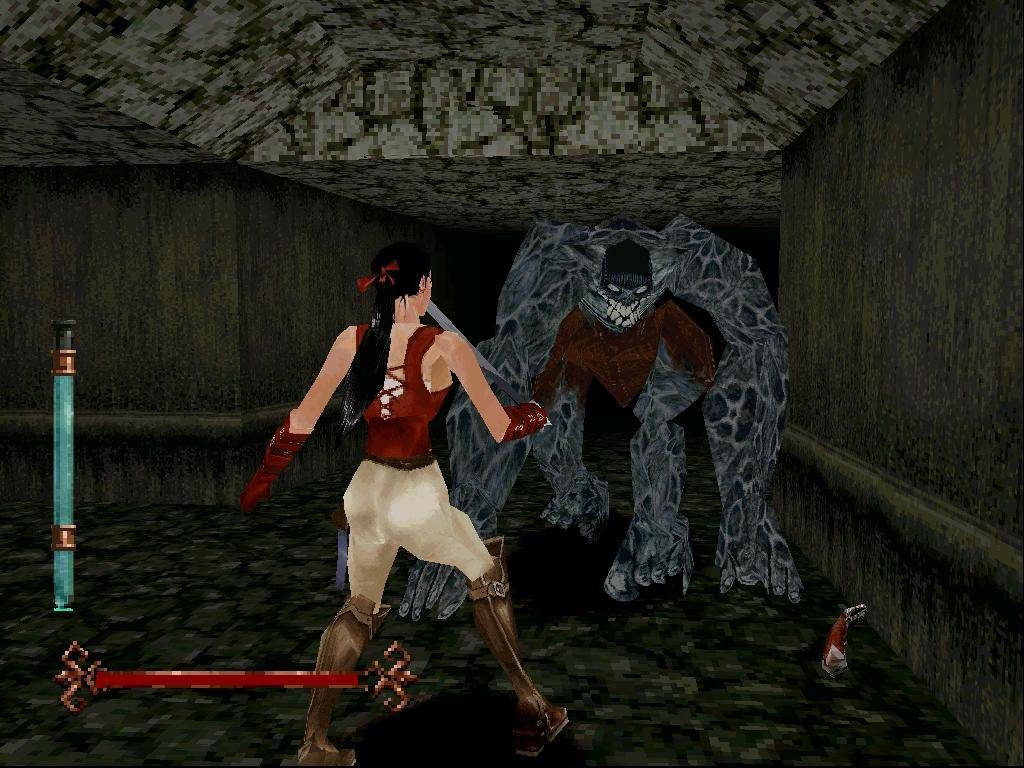Bushido Blade
A fighting game that really stood out upon its release in 1997, Bushido Blade was developed by Light Weight and published by Square, its weapons-based combat being especially interesting due to the game’s lack of health bars, meaning that just one hit can potentially kill your opponent. Also, non-lethal blows can cripple an opponent’s arm or leg, making it more difficult for them to fight back or move around. These punishing mechanics naturally give the combat a real feeling of tension.
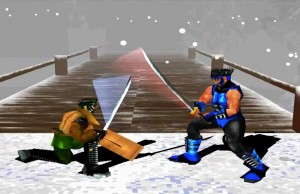
Bushido Blade features an array of bladed weapons – as well as a sledgehammer – to choose from; different stances offering different attacks; multiple playable characters with their own strengths and weaknesses; and several game modes.
A couple of other innovative features include the Bushido code being implemented in the story mode in the form of the player being punished for acting dishonourably, such as attacking your opponent while they bow; and the fact that fights don’t take place within a confined arena but rather an open, sprawling castle, meaning you can run and climb your way through a bamboo thicket, a dry moat and more, fighting all the while.
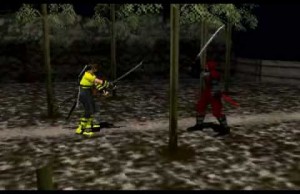
1998 saw the release of Bushido Blade 2 (although not in Europe, sadly). This sequel retains the core gameplay of its predecessor while making some changes, such as the removal of the expansive fighting arena; a different structure to the story mode; and a less diverse range of weapons and fighting styles. Since then, the closest we’ve come to a new entry in the series is PlayStation 2 spiritual successor Kengo: Master of Bushido.
While Bushido Blade’s combat may seem a little cumbersome today, the concept behind the gameplay remains sound, and so it would be great to see the series return, smoothing out any rough edges while expanding upon its innovative and interesting foundations.
Colony Wars
Developed and published by Psygnosis, the Colony Wars games formed an acclaimed trilogy on PlayStation, consisting of Colony Wars (1997), Colony Wars: Vengeance (1998) and Colony Wars: Red Sun (2000).
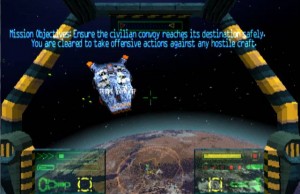
The Colony Wars games are ship-based shoot-‘em-ups set in a science-fiction universe, with the majority of missions taking place in space, although there are occasional missions set on planet surfaces. The series’ overarching story spans over a century, features a different protagonist in each game, and deals with a civil war raging across the stars, one which eventually involves alien life-forms as well as human.
Although there is certainly a focus on ship-to-ship dogfights, the Colony Wars games do an admirable job of mixing up the gameplay and keeping things interesting, tasking you with defending supply lines or important ships, infiltrating enemy territory, as well as a number of missions focusing on the destruction of various enemy forces.
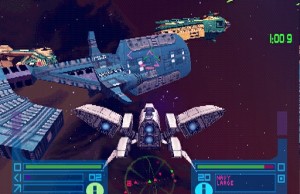
One particularly cool feature is that failure of a mission doesn’t always halt your overall progress – instead, the story branches off along a different path, one which takes your failure into account. The knowledge that your victories and defeats can affect events adds some narrative weight as well as a degree of replayability. Further depth is added via customisation options including a selection of ships, weapons and upgrades.
The recent success enjoyed by ship-based sci-fi titles such as Elite: Dangerous and Star Citizen has demonstrated that people are still hungry for such games, and while the Colony Wars series is certainly more action-orientated than these two examples, it’s a series which has stood the test of time well and which could easily make a triumphant return on PlayStation 4.
Fear Effect
When I originally played Fear Effect upon its release in 2000, I was struck by just how cool and stylish it was in terms of its narrative and visuals, being a visually striking, noir-infused blend of science fiction, crime, action and horror. Developed by Kronos Digital Entertainment and published by Eidos Interactive, the game is an action-adventure made up of combat, puzzles, a sprinkling of stealth, and frequent cut-scenes.
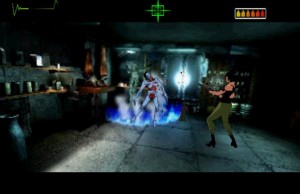
Alongside its excellent art design, the reason why Fear Effect stood out graphically is because it places cel-shaded, three-dimensional characters against more realistic, two-dimensional backgrounds, and rather than being static images, these backgrounds actually consist of (admittedly grainy) looping full-motion video, making them appear more animated and immersive.
While the gameplay has its low points, such as occasional difficulty spikes, Fear Effect isn’t a total case of style over substance, although personally I found I was able to persevere through the game’s shortcomings largely due to my enjoyment of the visuals, story and characters. As I mentioned above, the narrative blends the genres of crime, sci-fi, action and horror, and it manages to achieve this in a way that never comes across as jarring or forced, while the plot itself contains some dark and interesting twists and turns.
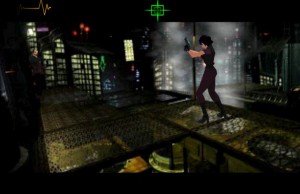
2001 saw the release of Fear Effect 2: Retro Helix, a prequel which adds a fourth protagonist to the original trio and which also places an increased emphasis on puzzle-solving. While a solid follow-up, in my opinion it doesn’t live up to the original. A third title, Fear Effect: Inferno, was planned for PlayStation 2 at one point, but sadly this was cancelled.
I’m confident that in the right hands, a third Fear Effect game could bring the series back in style by retaining what made the original so special while simultaneously improving and updating its more flawed and aging aspects.
Nightmare Creatures
You walk cobbled streets in the dead of night, armed with blade and pistol, battling monstrosities out for your blood. No, it’s not From Software’s action-RPG Bloodborne but rather 1997’s Nightmare Creatures, developed by Kalisto Entertainment and published by Sony Computer Entertainment.
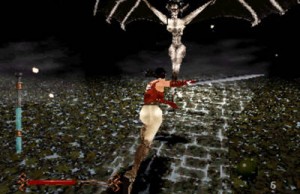
Nightmare Creatures is a horror-themed action-adventure set in London in 1834, your mission being to stop occultist Adam Crowley and the horde of murderous creatures he has unleashed. In order to cut down these werewolves, zombies, hulking behemoths, winged terrors, tentacled water-dwellers and more, you choose one of two distinct playable characters and utilise their respective melee weapon as well as secondary weapons such as pistols, dynamite, fire and magical spells.
The pace of the combat is kept up by a feature which causes you to begin losing health if you go too long without killing an enemy, encouraging aggressive play. Thankfully, this feature isn’t overly strict, meaning you still have time to explore the game’s streets, parks, sewers, docks, and other locations. Accompanied by a suitably menacing soundtrack, these environments are drenched in an excellent atmosphere of gothic horror.
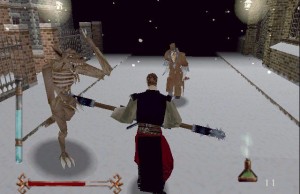
Although Nightmare Creatures received a sequel, Nightmare Creatures II (2000) turned out to be a pretty poor game. If you’re a Rob Zombie fan, however, and you’re not too busy watching any of his terrible movies, you may enjoy his songs which appear in the game. The series was intended to continue in 2003 with Nightmare Creatures 3: Angel of Darkness, but this third entry fell into development hell and never managed to claw its way back out.
Although visceral action and a gothic horror aesthetic are just two of Bloodborne’s many elements, that game’s success has proven that such a combination can still capture the attention of players, and so it would be great to see the Nightmare Creatures series return and spill blood (and maybe the odd organ or two) upon the foggy, cobbled streets of 19th-century London once again.
Emily Medlock is an avid gamer whose passions not only include video games of all kinds, but anime, music, movies, and reading.

